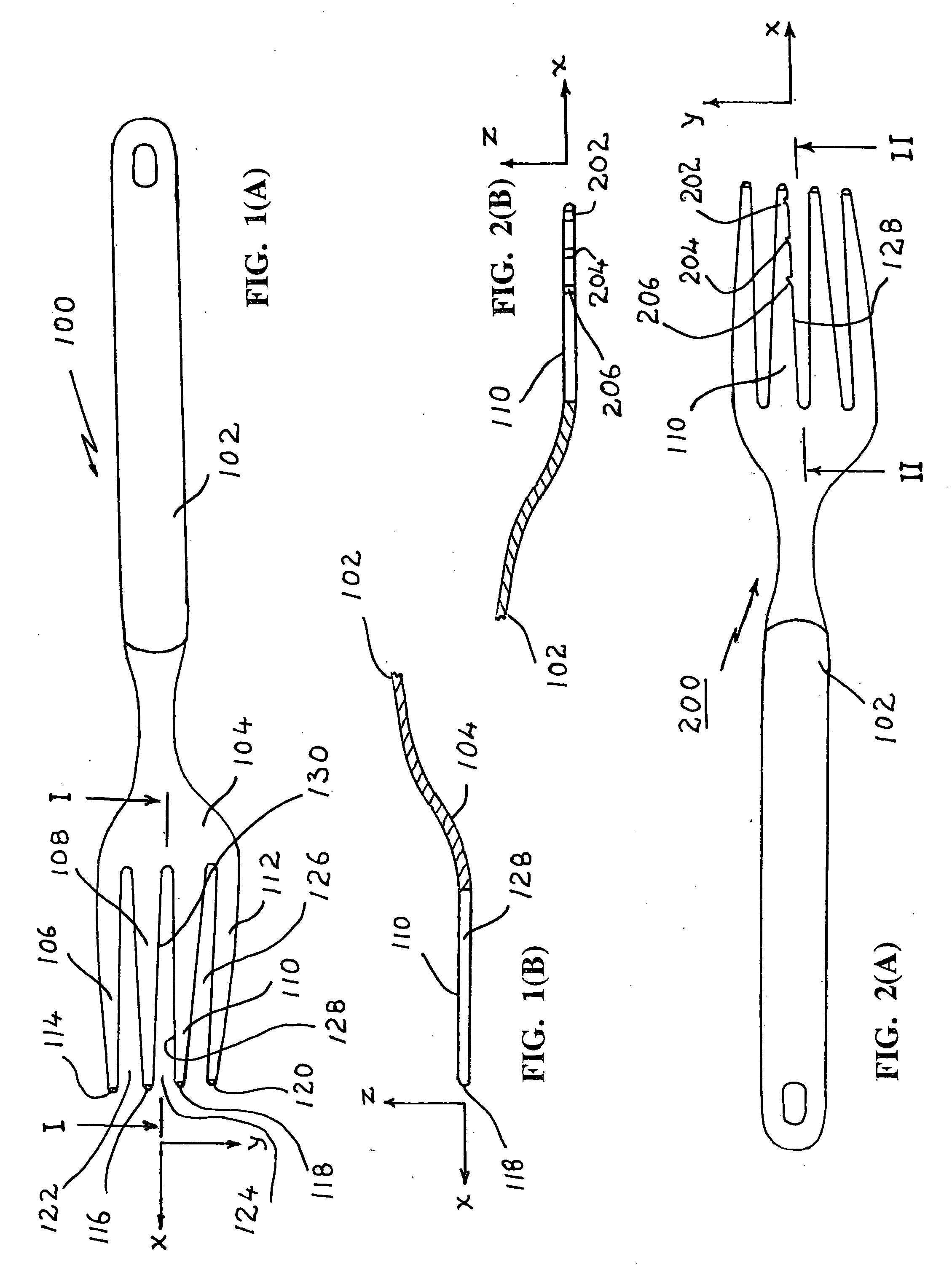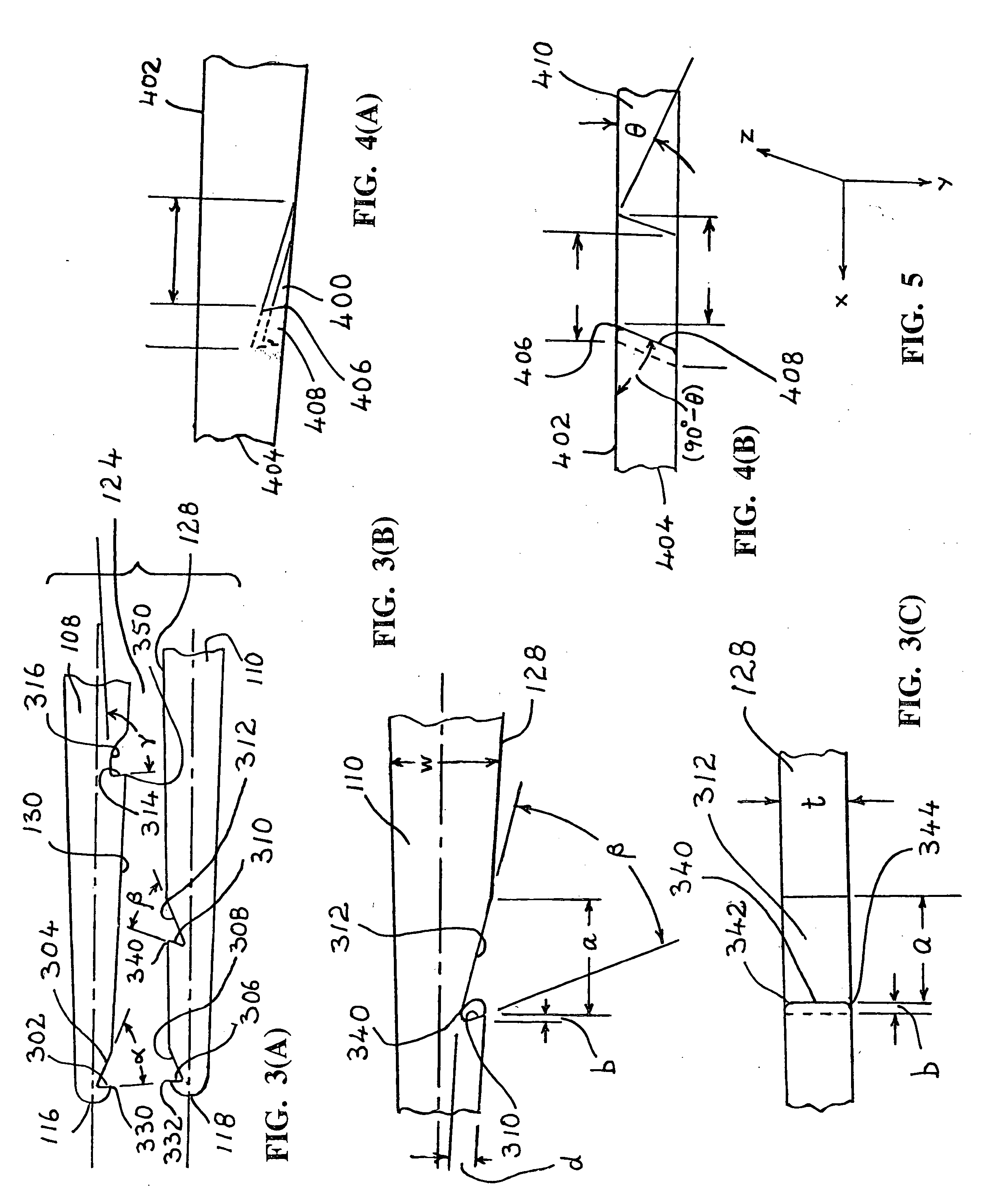Fork with multiple tines
- Summary
- Abstract
- Description
- Claims
- Application Information
AI Technical Summary
Benefits of technology
Problems solved by technology
Method used
Image
Examples
first embodiment
[0040]In the first embodiment per FIG. 3(A), essentially flat intersecting surfaces 302, 304 subtend an angle “α” very close to the tip 116 at the distal end of tine 108. The intersection of surface 302 and the gap-defining tine surface 130 creates an edge of a barb 330 very close to tip 116. Note that in this embodiment barb 330 that does not extend out of the tine 108 into gap 124. Note also that, to minimize the likelihood of food residue being trapped at the peak of angle “α”, during and after washing of the dining fork for subsequent reuse, this peak is smoothly rounded. This is best seen in FIG. 3(B).
[0041]The tip of a tine in a conventional dining fork is quite small, and with care it can be easily inserted into a small item of food, e.g., a single pea or single kernel of boiled corn. Having surface 302 very close to tip 116 ensures that when tip 116 with corresponding barb 330 is inserted into such a small item of food the food will become more strongly attached to tine 108 ...
third embodiment
[0044]FIG. 3(A) also shows a third embodiment, in which the topographic discontinuity is defined by the intersection of surfaces 314 and 316 with each other subtending an angle “γ”. Surface 314 intersects with the gap-defining surface of tine 108 to form barb 350 which has a sharpness intermediate that of barbs 330 and 340. The key distinction here is that the entire surface 316 is not a single plane, like surfaces 304 and 312, but has a curved end portion smoothly blending into tine surface 130. This creates a larger food capture volume behind barb 350 than was available behind otherwise comparably sized barbs 330 and 340. Such a feature may be more suitable for somewhat crumbly foods such as relatively heavy chunks of slippery food, e.g., ketchup-covered soft boiled sausage, sour cream-covered baked potato, or the like.
[0045]Preferred values for angles “α”, “β”, and “γ” range between about 45 to 90 degrees.
[0046]The maximum preferred depth “d” of any of the topographic discontinui...
fourth embodiment
[0050]FIGS. 4(A) and 4(B) respectively show in top plan view and side view a fourth embodiment, in which the topographic discontinuity is a wedge-shaped recess 400 formed at an angle “θ” relative to the top surface 402 of a dining fork tine 404 into the gap-defining side of the tine. This provides a more specific point 406 at the top of barb 408, subtending an angle (90-θ) degrees at the gap-defining surface 410. As noted earlier, all points, corners (inside and outside the food-capturing space of the recess), and edges should be rounded off to the degree deemed necessary to avoid injury to a user and for ease of washing the fork for reuse. The preferred maximum depth “d” of recess 400 into tine 404, as with the previously discussed embodiments, preferably is not more than about one half the local width “w” of the tine.
PUM
 Login to View More
Login to View More Abstract
Description
Claims
Application Information
 Login to View More
Login to View More - R&D
- Intellectual Property
- Life Sciences
- Materials
- Tech Scout
- Unparalleled Data Quality
- Higher Quality Content
- 60% Fewer Hallucinations
Browse by: Latest US Patents, China's latest patents, Technical Efficacy Thesaurus, Application Domain, Technology Topic, Popular Technical Reports.
© 2025 PatSnap. All rights reserved.Legal|Privacy policy|Modern Slavery Act Transparency Statement|Sitemap|About US| Contact US: help@patsnap.com



